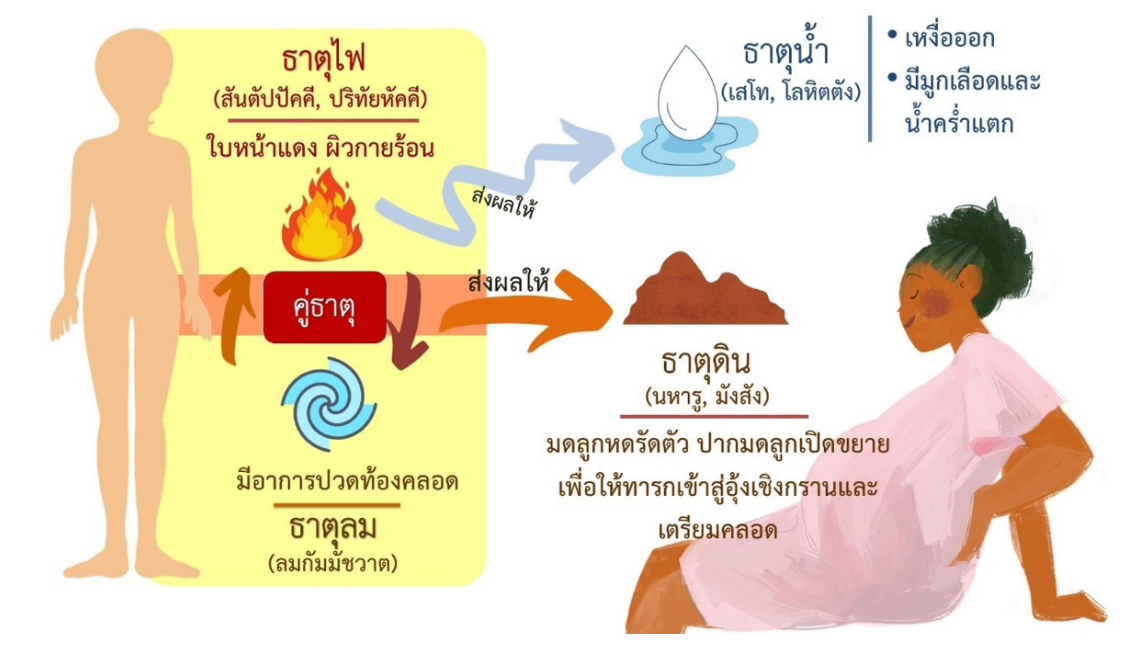A Thai Traditional Medicine Guideline: Caring Pregnant Women in Labor Room
Main Article Content
Abstract
Pregnant women go through a natural process called labor. The body undergoes modifications in order to prepare for normal labor during the stages of labor. Pregnant women become exhausted and suffer as a result of the changes that cause pain and stress during the stages of childbirth. Although some pregnant women choose for a cesarean section, it is not encouraged. Even though medical technology has evolved and become safer, vaginal delivery allows the body to recover more efficiently than a cesarean section. At the stages of labor in the labor room, applied Thai traditional medicine practitioner is one of the multidisciplinary teams. Thai traditional medicine emphasizes on bodily (court-type Thai traditional massage, hot compression, breathing exercise) and mental well-being (deep listening, healing touch), The goal is to assist pregnant women with pain relief and provide positive encouragement during stages of labor. The aim of the article is to provide information on the Thai traditional medicine guideline for pregnant women's care. The article includes knowledge of Thai traditional medicine in midwifery and an analysis of the changes of 4 body elements related to a labor process.
Article Details

This work is licensed under a Creative Commons Attribution-NonCommercial-NoDerivatives 4.0 International License.
References
เสฐียรโกเศศ. ประเพณีเกี่ยวกับชีวิต. กรุงเทพมหานคร: สำนักพิมพ์ศยาม; 2553.
ศุภลักษณ์ อิ่มแก้ว. พฤติกรรมการเผชิญความเจ็บปวดในระยะคลอดของชาวเขา. Thai Journal of Nursing Council. 2012;16(2):15-24.
ศศิธร เตชะมวลไววิทย์. ความปวดและการจัดการความปวดของมารดาในระยะที่หนึ่งของ การคลอด Journal of Boromarajonani College of Nursing, Bangkok. 2015;31(1):114-115.
มูลนิธิฟื้นฟูส่งเสริมการแพทย์ไทยเดิมฯ และโรงเรียนอายุรเวทธำรง สถานการแพทย์แผนไทยประยุกต์ คณะแพทยศาสตร์ศิริราชพยาบาล มหาวิทยาลัยมหิดล. ตำราการแพทย์ไทยเดิม (แพทย์ศาสตร์สงเคราะห์ ฉบับอนุรักษ์ เล่ม 1)2555.
โรงเรียนอายุรเวทธำรง สถานการแพทย์แผนไทยประยุกต์ คณะแพทยศาสตร์ศิริราชพยาบาล. การแพทย์แผนไทยในคณะแพทยศาสตร์ศิริราชพยาบาล. กรุงเทพมหานคร: ศุภวนิชการพิมพ์; 2552.
พระยาแพทย์พงศา วิสุทธาธิบดี. แพทย์ตำบล. กรุงเทพมหานคร: โรงพิมพ์อักษรนิติ; 2464.
เฉลียว สัตตมัย. โปรแกรมเตรียมคลอดโดยใช้แนวคิดจิตประภัสสรตั้งแต่นอนอยู่ในครรภ์ต่อผลลัพธ์การคลอดในผู้คลอดครรภ์แรก. วารสารการแพทย์โรงพยาบาลศรีสะเกษ สุรินทร์ บุรีรัมย์. 2011;26(1):32-47.
จิราวรรณ คล้ายวิเศษ, ศรีสมร ภูมนสกุล, จรัสศรี ธีระกุลชัย. ผลของการนวดและ/หรือการประคบร้อนต่อระดับความปวดในระยะปากมดลูกเปิดเร็วและ การรับรู้ประสบการณ์การคลอดของผู้คลอดครรภ์แรก. Rama Nurse Journal. 2016;22(3):14.
สลิตตา อินทร์แก้ว. ผลของการนวดแผนไทยต่อความปวดในระยะคลอด: มหาวิทยาลัยสงขลานครินทร์; 2555.
โรงเรียนอายุรเวทธำรง สถานการแพทย์แผนไทยประยุกต์ คณะแพทยศาสตร์ศิริราชพยาบาล. หัตถเวชกรรมแผนไทย(การนวดไทยแบบราชสำนัก) ตอนที่ 1 การนวดพื้นฐาน. กรุงเทพมหานคร: ศุภวนิชการพิมพ์; 2557.
โรงเรียนอายุรเวทธำรง สถานการแพทย์แผนไทยประยุกต์ คณะแพทยศาสตร์ศิริราชพยาบาล. หัตถเวชกรรมแผนไทย(การนวดไทยแบบราชสำนัก) ตอนที่ 2 การนวดจุดสัญญาณ. กรุงเทพมหานคร: ศุภวนิชการพิมพ์; 2557.
Chatchai Sawadhichai Panya Sananpanichkul, Yosapon Leaungsomnapa, and Paweena Yapanya, . Possible Role of Court-Type Thai Traditional Massage During Parturition:a Randomized Controlled Trial. International Journal of Therapeutic Massage and Bodywork. 2019;12.
สุทธชัย ใจบาล, ศุภรานันท์ เรืองพุก, ณัฐนันท์ แซ่ตั้ง. ความเหมาะสมของระยะเวลาในการประคบร้อน. วารสารหัวหินสุขใจไกลกังวล. 2559;2:66-76.






